Abstract
This paper analyzes the occupational risks associated with the activities of transporting and spreading bituminous emulsion, focusing on a specific technological process used in a company in Romania. This study aims to identify risk factors, systematically evaluate them, and propose preventive measures aimed at reducing occupational accidents and diseases. The main hazards identified include exposure to hazardous chemicals, mechanical risks generated by the equipment used, and ergonomic factors that may affect workers’ health. Given the specificity of the activity analyzed, there is currently a lack of relevant studies specifically addressing the occupational safety and health of this category of workers, which further highlights the novelty and importance of the present research. Based on the results obtained, recommendations are formulated for optimizing work conditions, including the use of appropriate protective equipment, improving operational procedures, and implementing effective technical and organizational measures. This study contributes to the development of a solid preventive framework in the field of transporting and applying bituminous emulsion, thus supporting the improvement of occupational safety and health in the road construction industry. The results obtained can be used to develop more effective policies in the field of occupational safety and to raise awareness among decision-makers about the need for proactive measures in preventing occupational risks.
Keywords:
safety; workplace safety; hazard; risk factors; occupational risks; method; preventive measures 1. Introduction
The process of identifying and assessing the risks of occupational injury and illness is an essential element in ensuring occupational health and safety [1,2]. This aspect is underlined by numerous studies that highlight the role of prevention in reducing the frequency and severity of adverse events in the workplace. By proactively identifying risks, organizations can adopt appropriate measures to prevent the occurrence of accidents and occupational illnesses, thus protecting employee health and improving the overall performance of activities [3,4,5].
A systematic and rigorous approach to this process allows for a holistic understanding of hazards and risk factors, including the interactions between them, thus leading to the development of effective and personalized intervention strategies for each work environment [6]. Moreover, such a process supports a reduction in indirect costs associated with accidents, such as productivity losses, damage to the organization’s image, and insurance costs, which are essential aspects for the organization’s long-term sustainability [7].
Beyond the impact on organizations, risk identification and assessment also have broader implications for public health, contributing to reducing the costs associated with occupational diseases and increasing overall well-being [8]. In this sense, risk management plays a crucial role in promoting an organizational culture based on safety, responsibility, and respect for employees, thus strengthening the relationship between management and human resources.
The main purpose of this study is to analyze the occupational risks associated with the activities of transporting and spreading bituminous emulsion. In this context, the following research objectives were established:
- The identification and assessment of the occupational risks associated with the process of transporting and spreading bituminous emulsion.
- Proposing practical solutions to reduce the identified risks and improve worker safety, adapted to the specific context of the company analyzed.
Thus, this study aims to highlight the relevance and benefits of a rigorous risk assessment, integrating both theoretical and practical perspectives.
To facilitate a clear and coherent understanding of the analyzed topic, this study was structured as follows:
- Section 2 provides a detailed description of the research methodology used in the process of identifying and assessing occupational risks, highlighting the stages, methods, and tools applied for data collection and analysis.
- Section 3 and Section 4 are dedicated to the centralization and analysis of the data obtained. This approach allows for the identification and centralization of the main occupational risks and the formulation of relevant conclusions by identifying appropriate measures to reduce occupational risks and improve worker safety.
- The last section presents the essential conclusions of this study. The identified limitations are also included, and future research directions are proposed, intended to contribute to deepening knowledge in this field, offering opportunities for improving occupational risk prevention strategies.
2. Materials and Methods
An Analysis of the Bituminous Emulsion Transportation and Spreading Process Carried out Within the Selected Company
The company in which this study was conducted offers integrated solutions for large-scale road projects. Among the main activities carried out by the company are the transport and spreading of bituminous emulsion, an essential process for the preparation and maintenance of road surfaces.
With extensive experience in the field, the company has specialized equipment with technologies that ensure the optimal transport and precise application of bituminous emulsion. These operations are carried out according to the highest quality and safety standards, thus contributing to increasing the durability and performance of roads.
Bituminous emulsion is a modern and effective solution for various applications in road infrastructure and other related fields. Bituminous emulsion is a liquid mixture consisting of bitumen, water, and an emulsifying agent. Bitumen, which is a viscous and impermeable material derived from petroleum refining, is dispersed as fine particles in water with the help of an emulsifier, which stabilizes the mixture and prevents phase separation. This emulsion is used as a binder for asphalt coatings or base layers, waterproofing, sealing or other specific uses requiring a waterproof barrier.
The activity of transporting and spreading bituminous emulsion involves the use of specialized equipment (tankers for transporting and spreading bituminous emulsion of 3 tons and 6 tons; mobile tank/reservoir for temporary storage of the emulsion at the customer’s site; manual tar spreaders (bituminous emulsion sprayers); motor pumps (petrol) for loading/unloading bituminous emulsion; transfer hoses, etc.) and exposes personnel to a series of professional risks. These risks are associated with handling hazardous materials, using complex mechanical equipment, and exposure to environmental and chemical factors.
The purpose of this study is to identify and analyze in-depth the risks of occupational accidents and illnesses, as well as to propose measures to prevent them.
The workplace for which the evaluation was carried out is a bituminous emulsion transport–spreading operator.
- Number of exposed persons: 5 persons.
- Exposure duration: 8 h/day, one work shift.
- Data collection period: 20–29 November 2024.
- The evaluation team included experts in the fields of engineering, psychology, and toxicology.
The technological process of transporting and spreading bituminous emulsion involves several stages that ensure the efficient performance of this activity and the maintenance of the quality of the bituminous emulsion during transportation and use. The essential stages and specific working methods of this process have been highlighted below:
- Filling the tanker with bituminous emulsion
- Checking the technical condition of the tanker and the spreading components before loading it and setting off on the journey; checking the fuel level (diesel) in the burner tank provided in the bituminous emulsion transport tanker.
- Positioning the tanker at the loading site.
- Participating in connecting the transfer/loading hose to the tanker and to the bituminous emulsion source (checking connections to prevent leaks).
- Participating in the process of loading the tanker with bituminous emulsion while monitoring the loading process and the filling level of the tanker to avoid overloading.
- Participating in the disconnection of the transfer hoses once the tank is filled to the desired level.
- Closing the tank lids to prevent leaks during transport.
- Emulsion transport
- Ensuring the optimal temperature for applying the bituminous emulsion during transport (50 °C).
- Starting the diesel burner (by pressing the piezoelectric button) and regulating the fuel flow to heat and maintain the bituminous emulsion at a constant temperature.
- Emulsion spreading
- Setting the spreading parameters (spreading pressure and flow rate).
- Positioning the tanker at the beginning of the work area and starting the bituminous emulsion spreading/spraying system.
- Preparing the road surface (cleaning and priming, if necessary).
- Spraying the emulsion evenly on the surface.
- Stopping the spreading system at the end of the application area.
- Cleaning the nozzles and the spraying system to prevent emulsion accumulation and clogging.
This study uses a mixed methodology, combining qualitative and quantitative analysis, to provide a broad and integrated understanding of the risks associated with the activities analyzed.
- Qualitative analysis was used to identify the main sources of risk through direct observation and semi-structured interviews with personnel involved in the activities of the transport and application of bituminous emulsion. The interviews were conducted with 5 employees (drivers, operators, technical staff), taking into account professional experience and level of exposure to risks. The questions were aimed in particular to identify activities perceived as critical, opinions on the effectiveness of the safety measures applied, and the perception of risks. The answers were correlated with field observations.
- The quantitative analysis consisted of assessing the identified risks using a standardized assessment grid, based on established occupational risk assessment methodologies. Each risk was assigned probability and severity scores, on a scale from 1 to 5, according to the applicable occupational health and safety standards. The values obtained were used to calculate the risk level, which allowed prioritizing them and formulating recommendations for prevention measures.
- The data necessary for this study were obtained using several methods.
- Direct observation of the bituminous emulsion transport and application activity, as well as the working conditions on the construction site, in order to identify critical processes and associated risk factors.
- Conducting interviews with company employees (operators, drivers, and technical staff) to collect information about the activities carried out, risk perception, and organizational safety culture, as well as previous experiences related to incidents or dangerous situations.
- Analysis of existing documentation (similar studies, occupational health and safety regulations, technical data sheets of equipment and substances used, bituminous emulsion safety data sheet, existing risk assessment reports, incident/accident registers, etc.) to verify the compliance of activities with legal requirements and to understand the existing procedural framework.
For the systematic assessment of risks, a methodological diagram of this process of the identification and assessment of occupational risks was created, as shown in Figure 1:
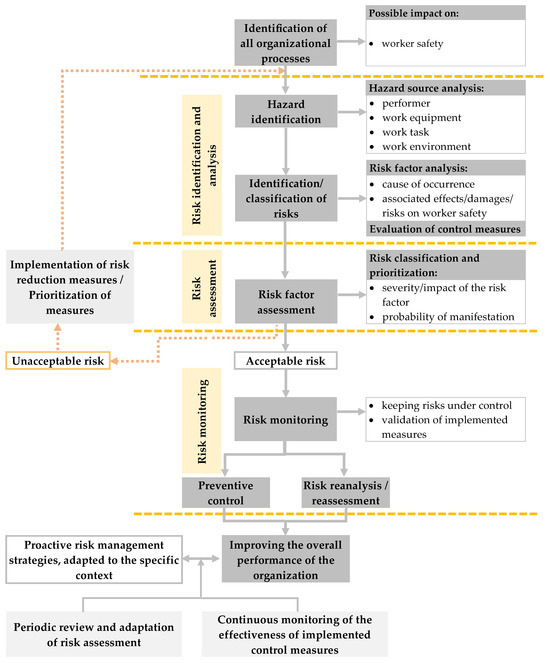
Figure 1.
A methodological diagram of the process of identifying and assessing occupational risks.
Each identified risk factor [9,10] was analyzed and classified according to potential severity/impact and probability of manifestation [1] according to a scale consisting of 5 distinct classes (1–5), as shown in Figure 2 and Table 1 and Table 2:
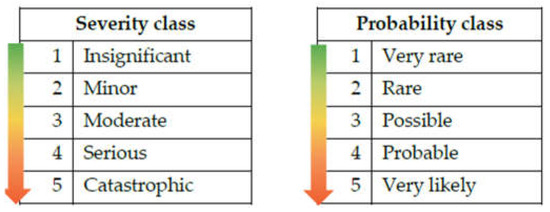
Figure 2.
Classification of risk factors according to potential severity/impact and probability of occurrence.

Table 1.
Classification of risk factors according to potential severity/impact.

Table 2.
The classification of risk factors according to the probability of manifestation.
Each of these classes (1–5) is defined by specific criteria, which provide a structured framework to guide the evaluation process—Figure 3.
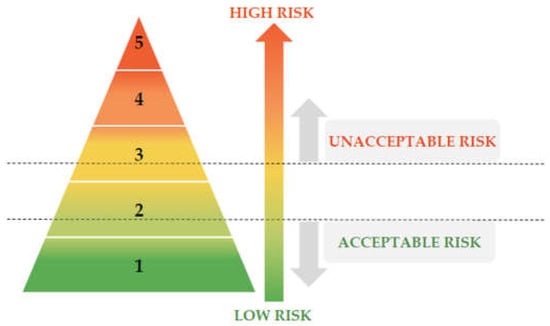
Figure 3.
Risk classification and assessment scale (1–5).
These five levels provide adequate differentiation for effective risk assessment while maintaining a balance between accuracy and simplicity.
The risk level is obtained by calculating the product of the severity of the consequences and the probability of the risk occurring, each risk factor being quantified by a specific score [11]:
Risk level = Severity (S) × Probability (P)
The risk level can range from 1, representing the lowest risk level, to 25, indicating the highest risk level. The calculated score allows for the systematic classification of risks, providing an objective basis for prioritizing them according to the degree of danger (Figure 4).

Figure 4.
Risk classification according to risk level.
This assessment method facilitates the allocation of resources and the implementation of prevention or control measures for cases in which the risks are more significant, thus contributing to the effective management of occupational safety and health. The justification for this system lies in its ability to provide a scalable and comparable approach, integrating both the probability and severity of impact to provide a complete picture of the level of risk, according to the risk classification matrix (based on severity and probability of incident), as shown in Figure A1.
This methodology is based on internationally recognized practices in risk management, such as those described in the ISO 31000 [12] and ISO 45001 [13] standards, which highlight the need for a detailed assessment of both the potential impact of risks and the probability of their occurrence [4,7,14]. By integrating these principles, the risk analysis process becomes more structured and efficient. This approach is widely applied in various industries, demonstrating its effectiveness in improving safety and reducing workplace incidents.
3. Results
3.1. Identification and Analysis of Risk Factors That Can Lead to Accidents and Occupational Illnesses in the Process of Transporting and Spreading Bituminous Emulsion
This approach involved the detailed identification of specific risks, taking into account both physical, chemical, and mechanical hazards, as well as ergonomic and psychosocial hazards. Subsequently, the identified risks were classified according to their level of severity and likelihood of occurrence, thus facilitating an objective assessment of their impact on the safety and health of workers. This classification constitutes a fundamental basis for proposing risk prevention and reduction measures, contributing to optimizing working conditions and increasing safety in this field of activity.
Table 3 provides a summary of the identified risk factors for occupational accidents and illnesses, as well as the classification of these identified risks according to the severity and probability of occurrence. The data are presented in a centralized form precisely to provide a clear and structured overview of all risk factors identified within the analyzed activities, while also highlighting their distribution according to the source of danger:

Table 3.
Centralization and classification of identified risks.
3.2. The Centralization of the Data Obtained
The weight of risk factors [11,15,16] corresponding to different sources of danger, as shown in Figure 5, constitutes an important indicator in the process of analyzing and assessing occupational risks. This distribution provided a clear insight into the relative contribution of each hazard source to the overall risk level, thus facilitating a systematic approach in identifying the most critical threats to worker safety and health.
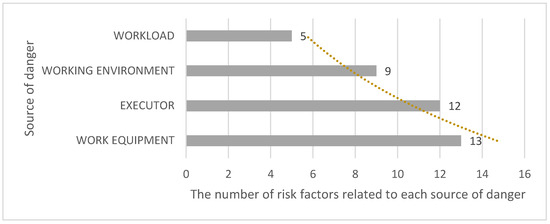
Figure 5.
Risk factors related to each source of danger.
The two sources of danger, work equipment (33%) and human factors (executor) (31%), account for 64% of the total risk factors identified. This indicates the need for priority measures in this direction. The working environment (23%) and workload (13%) are also important sources, but with a lower weight. Based on these findings, prevention and protection measures should be directed with priority toward equipment safety, personnel training, and the optimization of working conditions in order to reduce risks and improve workplace safety.
By quantifying and comparing risk factors (Figure 6 and Figure 7), the efficient prioritization of prevention and control measures was ensured, allowing for the optimal allocation of resources and the implementation of risk reduction strategies.
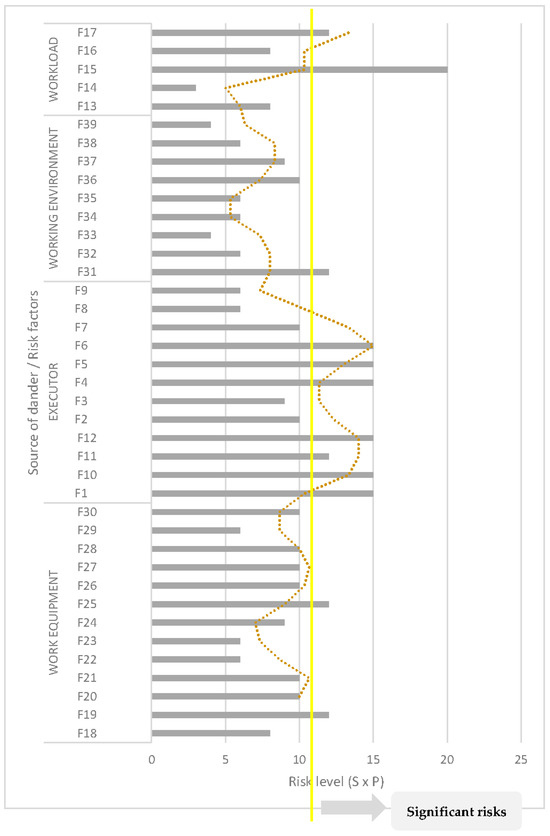
Figure 6.
The risk level associated with each risk factor.
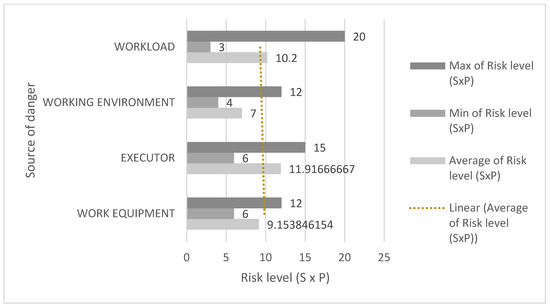
Figure 7.
The average risk level associated with each source of danger.
Thus, the use of this indicator contributes to the development of a more accurate and efficient risk management system, which has a direct impact on improving working conditions and reducing the incidence of accidents and occupational diseases.
4. Discussion
As this study shows, the process of transporting and spreading bituminous emulsion involves a series of significant risks in terms of both accidents and occupational illnesses, generated by exposure to hazardous factors, such as volatile chemicals, high temperatures, and difficult working conditions. These hazards can have a negative impact on the health and safety of workers. However, implementing effective prevention measures can significantly contribute to reducing these risks [17]. Thus, by analyzing the compliance and efficiency of existing protection measures, a series of recommendations was proposed to minimize occupational risks and improve worker safety [5,18,19,20]:
- Training operators regarding the consequences produced by the manifestation of specific risk factors and regarding their prevention measures.
- The training of personnel on the provisions of work procedures, equipment adjustment instructions, and occupational health and safety instructions when operating them, as well as on the obligation to check the technical condition of equipment, components, work tools, control devices, the existence and condition of fastening and fixing systems, locking and safety, etc., before use.
- Training operators on the mandatory check of the technical condition of all equipment before starting the race: checking the general condition of the tank (tank integrity, closure systems (lids, gaskets, safety valves), braking systems, steering, lights, tires, etc.); checking the fuel level (diesel) in the burner tank provided in the bituminous emulsion transport tank; checking the correct operation of the pumps; checking the transport pipes/hoses to detect any cracks or blockages; ensuring the pumps and pipes/hoses are suitable for the transfer of the emulsion, well maintained, and without defects; checking the correct operation of the level indicators to prevent overloading; and checking the correct operation of the temperature sensors to ensure the appropriate temperature of the emulsion for loading).
- Training workers on the measures to be taken to prevent work accidents and occupational diseases in workplaces where there are chemical substances/preparations that release toxic gases and vapors, and on providing first aid in case of irritations and injuries.
- Ensuring that workers are provided with personal protective equipment appropriate to the existing risks: protective masks, protective helmets with face shields/protective goggles, and chemical-protective neoprene and heat-resistant gloves.
- Equipping the tanker with emergency equipment: a fire extinguisher, a first aid kit, emergency eye and skin washing facilities, and personal protective equipment.
- Driver’s compliance with the provisions regulating traffic on public roads; compliance with speed restrictions, cautious approach to traffic, non-use of drugs or alcohol, adopting civilized behavior, etc.
- Planning travel routes with strict adherence to a driving/rest alternation; avoiding nighttime travel as much as possible.
- Equipment servicing by personnel properly trained and prepared on the operating method and the interventions that can be performed.
- Thus, by using appropriate equipment, through the periodic training of personnel and monitoring of working conditions, a safe and healthy working environment can be ensured for employees.
- To validate the conclusions, the results of this assessment were discussed with experts in the field of occupational health and safety, as well as with representatives of the company being analyzed. Thus, optimal solutions could be identified to improve working conditions and prevent occupational risks while also ensuring compliance with the legal regulations in force.
- Also, through this collaborative approach, the conclusions obtained from the evaluation were validated, and the proposed recommendations were adapted to the specific needs of the company. This approach also contributed to improving the efficiency of the proposed measures and their degree of acceptance within the company.
- However, it must be emphasized that this study is descriptive in nature, being limited to the analysis of a single organizational case, which restricts the possibility of generalizing the results to other companies or fields of activity.
5. Conclusions
The methodology applied in this study ensures a systematic and detailed approach to the assessment of occupational risks in the process of transporting and applying bituminous emulsion.
The results obtained provide a significant contribution and have relevant implications for this analyzed process.
First of all, by identifying and assessing in detail the occupational risks specific to the bituminous emulsion transport and spreading process, this study allowed for a thorough understanding of the main dangers to which workers in this sector are exposed. This analysis provided a solid basis for the development of effective risk management strategies.
Secondly, an analysis of the compliance and efficiency of existing protection measures was conducted, and proposals were formulated to improve security policies and procedures, with the main objective of reducing exposure to risks and increasing the level of employee protection.
An essential contribution of this study consists of proposing concrete solutions for reducing occupational risks, adapted both to legislative requirements and to the specifics of the activities within the process of transporting and spreading bituminous emulsion. Therefore, this study provides valuable support for decision-makers and companies in this field, contributing to the development of more effective worker protection policies.
Although this study provides valuable insight into the occupational risks associated with this activity, there are several limitations that must be considered for the correct interpretation of the results:
- This study was conducted in a single company in Romania, which limits the applicability of the conclusions to other organizations or similar technological processes. Certain factors, such as the specifics of the activities, technological facilities, or organizational culture, may vary significantly from one company to another. The descriptive nature of the research, focused on the detailed analysis of a particular case, does not allow for the formulation of generally valid conclusions for the entire industry. The results obtained strictly reflect the organizational context studied and, therefore, must be interpreted with caution when trying to extrapolate them to other organizational environments. However, the rigorous description of the risk assessment stages can constitute a valuable reference for professionals involved in occupational health and safety management, providing a concrete example of the application of analysis methodologies in a real context.
- The number of employees involved in interviews and direct observation (5 people) can be considered relatively small. Although the data collected are relevant to the company analyzed, the small sample size limits the validation of the conclusions.
- This study was conducted over a limited period of time (8 days), which did not allow for the analysis of risks that may arise seasonally or in different operational contexts. An analysis over a longer period of time would have provided a deeper understanding of the dynamics of those risks.
- Semi-structured interviews with employees were based on their subjective perceptions of workplace risks and safety. While this information is valuable, it may introduce a degree of bias into the overall risk assessment.
- This study did not address in detail the potential of technological innovations (e.g., automation, digitalization) in reducing risks. Integrating these factors could expand the relevance of the research and the proposed solutions.
Thus, these limitations highlight the need for future studies that extend the analysis to more companies, include a larger sample, and integrate data collection methods over a longer period of time. Despite these limitations, this study provides a solid basis for understanding and managing risks in the analyzed activities, contributing to the development of an organizational culture focused on occupational health and safety.
Author Contributions
Conceptualization, A.M. and L.-I.C.; methodology, A.M. and L.-I.C.; software, A.M.; validation, L.-I.C.; formal analysis, A.M.; investigation, A.M. and L.-I.C.; resources, L.-I.C.; writing—original draft preparation, A.M.; writing—L.-I.C.; visualization, A.M. and L.-I.C.; supervision, L.-I.C.; project administration, A.M. All authors have read and agreed to the published version of the manuscript.
Funding
This research received no external funding.
Institutional Review Board Statement
The study procedure and instruments were approved by the Ethics Committee of the Lucian Blaga University of Sibiu, Romania (NR.02-14.07/2022).
Informed Consent Statement
Not applicable.
Data Availability Statement
The data are contained within the article.
Conflicts of Interest
The authors declare no conflicts of interest.
Appendix A
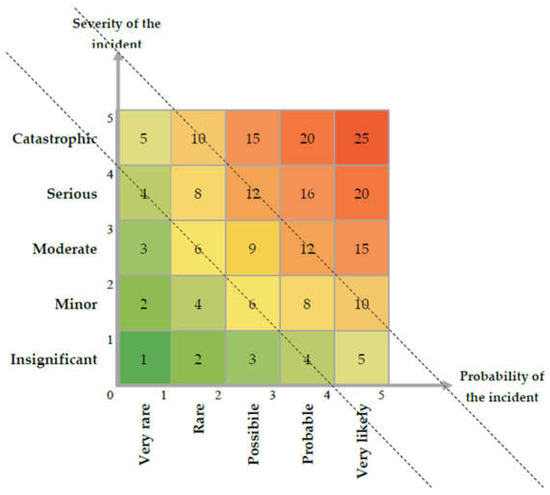
Figure A1.
Risk classification matrix (based on severity and probability of incident).
References
- Milea (Pârvu), A.; Cioca, L.I. Assessment of Emerging Risks-is the INCDPM Method, Appropriate for the Assessment of Emerging Risks? Proc. Int. Conf. Bus. Excell. Sciendo 2024, 18, 2300–2310. [Google Scholar] [CrossRef]
- Ramos, D.; Cotrim, T.; Arezes, P.; Baptista, J.; Rodrigues, M.; Leitão, J. Frontiers in Occupational Health and Safety Management. Int. J. Environ. Res. Public Health 2022, 19, 10759. [Google Scholar] [CrossRef] [PubMed]
- Moraru, R.I.; Băbuţ, G.B.; Popescu–Stelea, M.; Szabo, Z.-G. Shifting towards Proactive OHS Risk Management in Romanian Organizations: Systematic Benchmarks. MATEC Web Conf. 2021, 343, 10005. [Google Scholar] [CrossRef]
- Moraru, R.I. Occupational and Industrial Security: University Treatise; Universitas Publishing House: Petroșani, Romania, 2023; pp. 166–200. [Google Scholar]
- Lindholm, M.; Reiman, A.; Väyrynen, S. On Future Occupational Safety and Health Challenges. Int. J. Occup. Environ. Saf. 2020, 4, 108–127. [Google Scholar] [CrossRef]
- Drăghici, A.; Căruțașu, N. Occupational Risk Management, 2nd ed.; Politehnica Press Publishing House: Bucharest, Romania, 2020. [Google Scholar]
- Milea, A.; Cioca, L.I. Work evolution and safety and health at work in Industry 4.0/Industry 5.0. MATEC Web Conf. 2024, 389, 00074. [Google Scholar] [CrossRef]
- Banaduc, G.; Balla, A.; Biholar, A.I. A study of well-being impact on work effectiveness. Acta Tech. Napoc. 2024, 67, 249–256. [Google Scholar]
- Bejinariu, C.; Darabont, D.C.; Burduhos-Nergis, P.; Cazac, A.M.; Chiriac-Moruzzi, C. Considerations Regarding the Application of the Occupational Injury and Illness Risk Assessment Method at Workplaces/Workstations, in Relation to the ISO 45001 Standard. Sustainability 2023, 15, 2121. [Google Scholar] [CrossRef]
- Abeje, M. Innovating Safety Risk Assessment in Large-Scale Manufacturing Enterprises: A Holistic Approach. JETIR 2024, 11, 472–489. [Google Scholar]
- Băbuț, G.B.; Moraru, R.I. Critical analysis and ways to improve the I.N.C.D.P.M. Bucharest method for assessing the risks of occupational accidents and illnesses. Qual.-Access Success 2013, 14, 113–120. [Google Scholar]
- ISO. Available online: https://www.iso.org/obp/ui/en/#iso:std:iso:ts:31050:ed-1:v1:en:en (accessed on 23 February 2025).
- SR EN ISO 45001:2023; Sisteme de Management al Sănătății și Securității în Muncă. Cerințe și Îndrumări Pentru Utilizare. ISO: Geneva, Switzerland, 2023.
- Mariken, M.H.C.; Blom, H.A.P. Safety Methods Database. 2020. Available online: https://www.nlr.nl/wp-content/uploads/2021/12/Safety-Assessment-Techniques-Database_1.2_3-Nov-2020.pdf (accessed on 23 February 2025).
- Pece, A.; Dăscălescu, Ș. Method for Assessing the Risks of Occupational Accidents and Diseases in the Workplace; Ministry of Labor and Social Protection-Scientific Research Institute for Labor Protection: Bucharest, Romania, 1998.
- Băbuţ, G.B. Methods for Assessing the Risks of Occupational Injury and Illness–Course Support. 2009. Available online: https://www.researchgate.net/publication/385286127_Methods_for_identifying_and_assessing_risks_of_occupational_injury_and_disease_-_their_suitability_for_assessing_emerging_risks (accessed on 6 May 2025).
- Moraru, R.I.; Păun, A.P.; Dura, C.C.; Dinulescu, R.; Potcovaru, A.-M. Analysis of the drivers of Occupational Health and Safety performance disclosures by Romanian companies. Econ. Comput. Econ. Cybern. Stud. Res. 2020, 54, 197–214. [Google Scholar] [CrossRef]
- Costantino, F.; Falegnami, A.; Fedele, L.; Bernabei, M.; Stabile, S.; Bentivenga, R. New and Emerging Hazards for Health and Safety within Digitalized Manufacturing Systems. Sustainability 2021, 13, 10948. [Google Scholar] [CrossRef]
- Ivascu, L.; Cioca, L.I.; Banciu, D.; Filip, F.G. Digital Transformation. Exploring the Impact of Digital Transformation on Organizational Processes; Springer, Intelligent Systems Reference Library: Berlin/Heidelberg, Germany, 2024. [Google Scholar] [CrossRef]
- Gholamizadeh, K.; Zarei, E.; Kabir, S.; Mamudu, A.; Aala, Y.; Mohammadfam, I. A Knowledge-Driven Model to Assess Inherent Safety in Process Infrastructure. Safety 2023, 9, 37. [Google Scholar] [CrossRef]
Disclaimer/Publisher’s Note: The statements, opinions and data contained in all publications are solely those of the individual author(s) and contributor(s) and not of MDPI and/or the editor(s). MDPI and/or the editor(s) disclaim responsibility for any injury to people or property resulting from any ideas, methods, instructions or products referred to in the content. |
© 2025 by the authors. Licensee MDPI, Basel, Switzerland. This article is an open access article distributed under the terms and conditions of the Creative Commons Attribution (CC BY) license (https://creativecommons.org/licenses/by/4.0/).